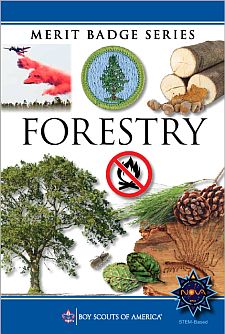Note: This merit badge has been changed to allow a Scout's guardian
to approve or permit some activities
such as use of the internet or meetings with individuals that are not registered
members of BSA.
In each case parent's has been replaced by
parent or guardian's
- Prepare a field notebook, make a collection, and identify 15 species
of trees, wild shrubs, or vines in a local forested area. Write a description
in which you identify and discuss the following:
- The characteristics of leaf, twig, cone, or fruiting bodies
- The habitat in which these trees, shrubs or vines are found.
- The important ways each tree, shrub, or vine is used by humans or wildlife and whether the species is native or was introduced to the area. If it is not native, explain whether it is considered invasive or potentially invasive.
- Do ONE of the following:
- Collect and identify wood samples of 10 species of trees. List several ways the wood of each species can be used.
- Find and examine three stumps, logs, or core samples that show variations in the growth rate of their ring patterns. In the field notebook you prepared for requirement 1, describe the location or origin of each example (including elevation, aspect, slope, and the position on the slope), and discuss possible reasons for the variations in growth rate. Photograph or sketch each example.
- Find and examine two types of animal, insect, or disease damage to trees. In the field notebook you prepared for requirement 1, identify the damage, explain how the damage was caused, and describe the effects of the damage on the trees. Photograph or sketch each example.
- Do the following:
- Describe contributions forests make to:
- Our economy in the form of products.
- Our social well-being, including recreation
- Soil protection and increased fertility.
- Clean water.
- Clean air. (carbon cycling, sequestration)
- Wildlife habitat
- Fisheries habitat
- Threatened and endangered species of plants and animals
- Tell which watershed or other source your community relies on for its water supply.
- Describe contributions forests make to:
- Describe what forest management means, including the following:
- Multiple-use management
- Sustainable forest management
- Even-aged and uneven-aged management and silvicultural systems associated with each type.
- Intermediate cuttings.
- The role of prescribed burning and related forest management practices.
- With your parent's parent
or guardian's and counselor's approval, do ONE of the following:
- Visit a managed public or private forest area with its manager or a forester familiar with it. Write a brief report describing the type of forest, the management objectives, and the forestry techniques used to achieve the objectives.
- Take a trip to a logging operation or wood-using industrial
plant and write a brief report describing:
- The species and size of trees being harvested or used and the location of the harvest area or manufacturer.
- The origin of the forest or stands of trees being utilized (e.g., planted or natural)
- The forest's successional stage. What is its future?
- Where the trees are coming from (land ownership) or where they are going (type of mill or processing plant)
- The products that are made from the trees
- How the products are made and used.
- How waste materials from the logging operation or manufacturing plant are disposed of or utilized.
- Take part in a forest-fire prevention campaign in cooperation with your local fire warden, state wildfire agency, forester, or counselor. Write a brief report describing the campaign, how it will help prevent wildfires, and your part in it.
- In your camp, local recreation area (park or equivalent), or neighborhood, inventory the trees that may be a hazard to structures or people. Make a list by area (campsite, road, trail, street, etc.). Note the species and hazardous condition, and suggest a remedy (removal or trimming). Make your list available to the proper authority or agency.
- Do the following:
- Describe the consequences to forests that result from FIVE of the following elements: wildfire, absence of fire, destructive insects, loss of pollinating insect population, tree diseases, air pollution, overgrazing, deer or other wildlife overpopulation, improper harvest, and urbanization.
- Explain what can be done to reduce the consequences you discussed in 7a.
- Describe what you should do if you discover a forest fire and how a professional firefighting crew might control it. Name your state or local wildfire control agency.
- Visit one or more local foresters and write a brief report about the person (or persons). Or, write about a forester's occupation including the education, qualifications, career opportunities, and duties related to forestry.
BSA Advancement ID#:
54
Scoutbook ID#:
55
Requirements last updated in:
2019
Pamphlet Publication Number:
35901
Pamphlet Stock (SKU) Number:
618658
Pamphlet Revision Date:
2015
|
|||||||
Page updated on: January 11, 2024









